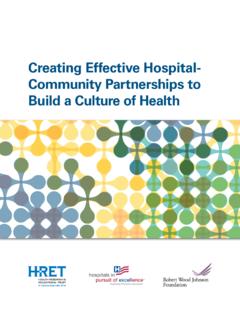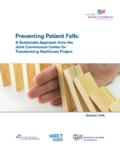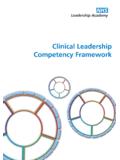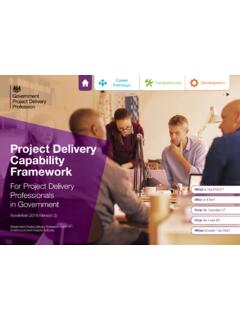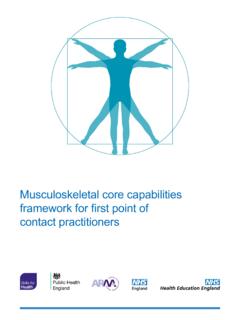Transcription of A Guide to Strategic Cost Transformation in Hospitals and ...
1 Signature Leadership Series A Guide to Strategic cost Transformation in Hospitals and Health Systems March 2012. A Guide to Strategic cost Transformation in Hospitals and Health Systems James W. Blake, Managing Director Brian S. Channon, Senior Vice President Mark E. Grube, Managing Director Jason H. Sussman, Managing Director Kaufman, Hall & Associates, Inc. 5202 Old Orchard Road, Suite N700. Skokie, IL 60077. (847) 441-8780. Suggested Citation: A Guide to Strategic cost Transformation in Hospitals and Health Systems. Health Research & Educational Trust and Kaufman, Hall & Associates, Inc., Chicago: March 2012. Accessed at Available at: Contact: Natasha Goburdhun, MPH, or (312) 422-2623. 2012 Health Research & Educational Trust and Kaufman, Hall & Associates, Inc. All rights reserved. All materials contained in this publication are available to anyone for download on , , or for personal, noncommercial use only.
2 No part of this publication may be reproduced and distributed in any form without permission of the publisher, or in the case of third party materials, the owner of that content, except in the case of brief quotations followed by the above suggested citation. To request permission to reproduce any of these materials, please email A Guide to Strategic cost Transformation in Hospitals and Health Systems 3. Executive Summary Exacerbated by the deficit and other economic challenges, the rising cost of health care is a front-and-center issue nationwide for patients, employers, providers, and govern- mental and commercial payers alike. As health care moves to a value-based business model, health care payments will likely be constrained, while care efficiency, quality, outcomes, and access will be expected to improve. To continue meeting community health care needs in this new delivery and payment environment, hospital and health system leaders will need to think and act strategically about managing cost .
3 Strategic cost Transformation will be required. In this Guide , we propose that such Transformation must occur along three pathways (see figure 1 on page 7): Pathway 1 involves reducing costs of current operations; path- way 2 involves reducing costs through restructuring businesses and service lines, among other elements; and pathway 3 involves reducing costs through clinical Transformation . This Guide focuses on specific elements of pathways 1 and 2. Hospitals and health systems can lay the groundwork for Strategic cost management by: Ensuring that the CEO drives the Strategic cost Transformation process Developing and implementing a Strategic cost Transformation master plan Bolstering the organization's business platform and ensuring its full functioning at all levels Creating and supporting cultural change cost management pathway (pathway 1): cost management is an approach to significantly reshape and reduce cost by (1) improving planning and execution of current operations and (2) attacking overhead and non value-added functions, overhead costs, and costs flying below the radar.
4 cost management opportunities can best be achieved in organi- zations through: 1. Understanding your organization's readiness for cost management 2. Defining cost -reduction goals based on the organization's capital shortfall 3. Using internal and external benchmarks to identify possible sources of savings 4. Supplementing benchmark data with other data analyses 5. U. nderstanding and focusing on the key drivers of staffing and productivity problems 6. Drilling down on staffing methods 7. Streamlining overhead functions 8. E nsuring that cost -reduction targets are integrated with organizational plans and budgets Business restructuring pathway (pathway 2): Forward-thinking organizations, whether freestanding Hospitals , multihospital systems, or other provider entities, are evaluating all aspects of their business in light of changing market conditions and requirements for future success under the new business model.
5 They are asking, What businesses and services are core to our mission and vision going forward? and Where can we most ef- fectively invest our limited capital and human resources to meet the continuing health care needs in our communities? . 4 A Guide to Strategic cost Transformation in Hospitals and Health Systems Eight action items can help hospital and health system executives and boards define the business strategies appropriate to their organizations, and the plan by which those strate- gies can be executed. 1. Start with an evaluation of your organization's Strategic options. 2. Evaluate each business unit and service line to identify core elements. 3. Use a structured process to analyze the core businesses and services. 4. Implement a business/service line analysis framework. 5. Understand when and why service distribution planning will be needed. 6. I nitiate the process of defining the most efficient and effective distribution of services.
6 7. Use a structured framework for service distribution planning. 8. Ensure a solid fact base for the service distribution plan. hospital and health system leaders have an opportunity to make a significant contribution to health care delivery in their communities by moving their organizations to a value- based business model, using the strategies of Strategic cost Transformation outlined here. The time to move is now. A Guide to Strategic cost Transformation in Hospitals and Health Systems 5. Introduction Due to factors including the federal and state budget deficits, rising health care costs, and the large percentage of gross domestic product consumed by health care spending, health care must focus on value. This value proposition, which is improved quality at lowest-possible cost , will not be undone. Under health care's value-based business model, health care payments will be constrained, while care efficiency, quality, outcomes, and access will be expected to improve.
7 At the same time, quality and cost will be much more transparent to patients and purchasers. Indicators will be closely monitored and reported in public forums. To continue meeting community health care needs in the new delivery and payment environment, hospital and health system leaders will need to think and act strategically about managing cost . In this Guide , we propose that this process Strategic cost transfor- mation will be required and that such Transformation must occur along three pathways (see figure 1): Pathway 1 involves traditional cost management, namely reducing costs of current operations; pathway 2 involves reducing costs through restructuring businesses and service lines, among other elements; and pathway 3 involves reducing costs through clinical Transformation . Most organizations have attacked or are currently attacking costs through pathway 1. But these savings may not be sufficient to achieve the overall cost reductions needed in the new environment.
8 Furthermore, to ensure optimal long-term success, work occurring through pathway 1 must be carefully coordinated with work occurring through pathways 2 and 3. Some organizations have started to use pathway 2, business restructuring, as a means to reduce costs; but this work is much more difficult, and many organizations have not yet started it. Finally, though many providers talk about clinical Transformation , many organizations have not started work in pathway 3, which takes the longest time to achieve but also has significant potential for true reduction of the cost of care. This Guide focuses on specific elements of: P athway 1. cost management: Reducing costs of management operations, including planning and execution, nonlabor costs, overhead costs, and costs flying below the radar . Pathway 2. Business restructuring: Reshaping businesses and services offered and conducting service distribution planning Future guides in this series will cover additional pathway elements.
9 6 A Guide to Strategic cost Transformation in Hospitals and Health Systems Figure 1. Three Pathways for Strategic cost Transformation Strategic cost Transformation 1. 2. 3. cost Management Business Clinical Restructuring Transformation Planning and Businesses/ Care processes execution services offered Nonlabor costs Service Physician distribution integration Overhead costs Facility planning Effective care transitions Costs below the Enhanced capital Relationships with radar allocation other providers Supply chain/ Enterprise risk revenue cycle management Source: Kaufman, Hall & Associates, Inc. Used with permission. Laying the Groundwork For health care management teams and boards, four strategies will be critical to achieving Strategic cost Transformation . Strategy 1. Ensure that the CEO drives the Strategic cost Transformation process. Removing costs to increase efficiency across an organization, while improving quality, will require sustained effort and attention at the highest level.
10 Strategy 2. Develop and implement a Strategic cost Transformation master plan. The plan articulates the order and sequencing of pursuit and achievement of the cost - Transformation pathways. While pursuit of all three pathways is likely required, it may be beyond a management team's resources to pursue initiatives in all areas simultaneously. Some CEOs are very unsure of what they should do first. Many are diving into clinical integration and care-model change. Others are pursuing initiatives to enhance services or secure partnerships. Or, if the hospital or health system is experiencing relatively stable financial performance, some CEOs are focusing on revenue or integration initiatives in lieu of cost reduction because they believe what is commonly cited in the literature that the low-hanging fruit has already been picked. This may not be the case. Very few organizations seem to have the time and human and economic resources to pursue all pathways concurrently.

